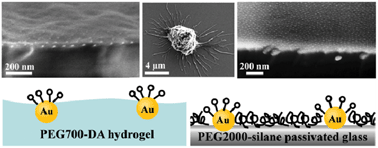Surface properties of nanostructured bio-active interfaces: impacts of surface stiffness and topography on cell–surface interactions†
Abstract
Due to their ability to confer key functions of the native extracellular matrix (ECM), poly(ethylene glycol) (PEG)-based and PEG-modified materials have been extensively used as biocompatible and bio-functionalized substrate systems to study the influence of environmental parameters on cell adhesion in vitro. Given wide-ranging recent evidence that ECM compliance influences a variety of cell functions, detailed determination and characterization of the specific PEG surface characteristics including topography, stiffness and chemistry is required. Here, we studied two frequently used bio-active interfaces—PEG-based and PEG-modified surfaces—to elucidate the differences between the physical surface properties, which cells can sense and respond to. For this purpose, two sets of surfaces were synthesized: the first set consisted of nanopatterned glass surfaces containing cRGD-functionalized gold nanoparticles surrounded by a passivated PEG-silane layer and the second set consisted of PEG-diacrylate (PEG-DA) hydrogels decorated with cRGD-functionalized gold nanoparticles. Although the two sets of nanostructured materials compared here were highly similar in terms of density and geometrical distribution of the presented bio-ligands, as well as in terms of mechanical bulk properties, the topography and mechanical properties of the surfaces were found to be substantially different and are described in detail. In comparison to the very stiff and ultra-smooth surface properties of the PEG-passivated glasses, the mechanical properties of PEG-DA surfaces in the biologically relevant stiffness range, together with the increased surface roughness at micro- and nanoscale levels have the potential to affect cell behavior. This potential was verified by studying the adhesive behavior of hematopoietic KG-1a and rat embryonic fibroblast (REF52) cells on both surfaces.


 Please wait while we load your content...
Please wait while we load your content...